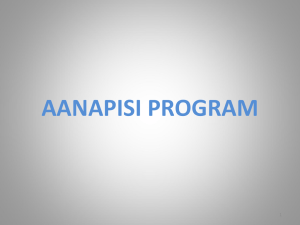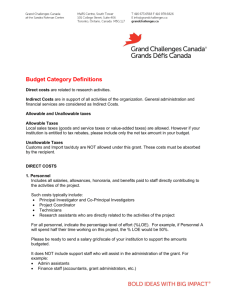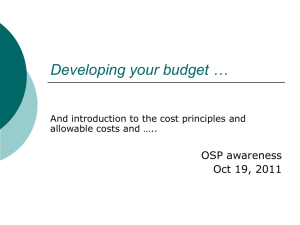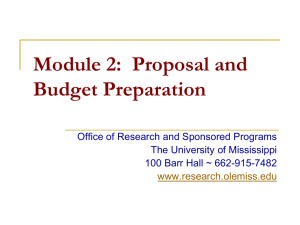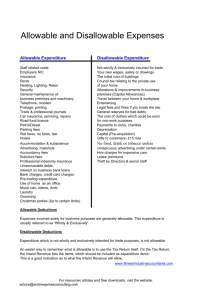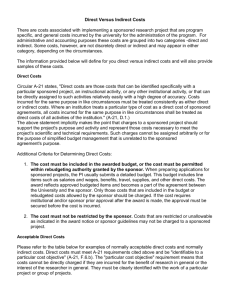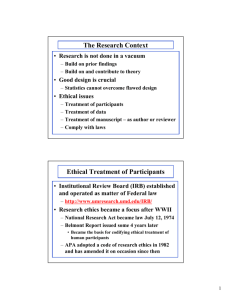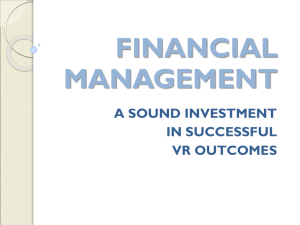how to distinguish between direct and indirect charges
advertisement
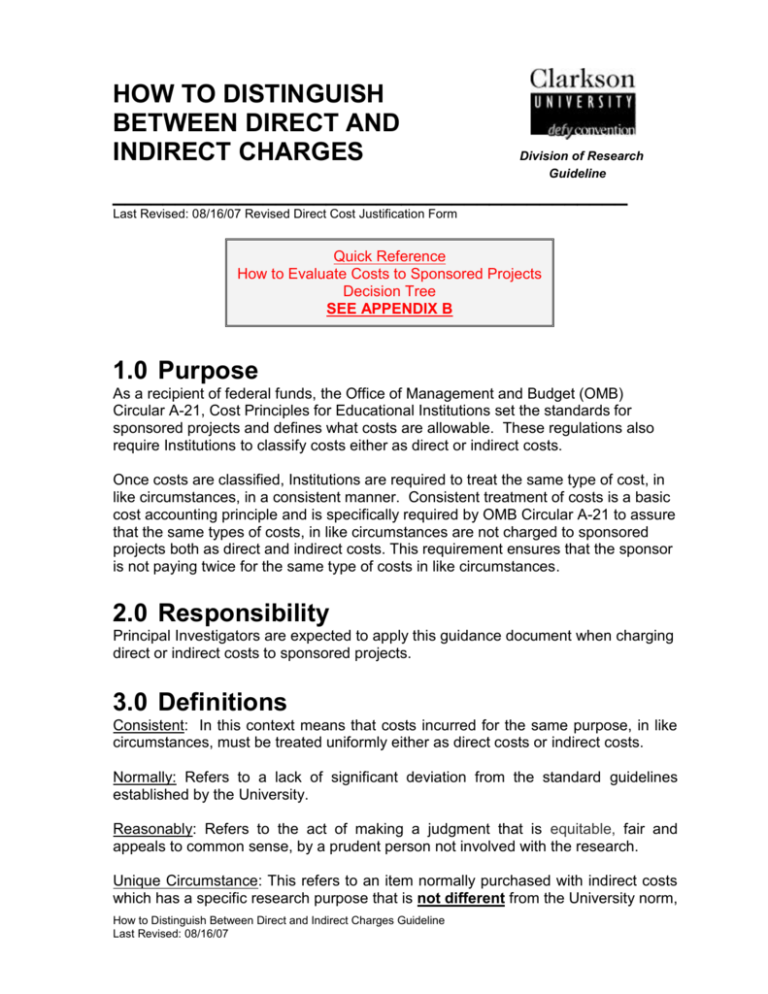
HOW TO DISTINGUISH BETWEEN DIRECT AND INDIRECT CHARGES Division of Research Guideline _________________________________________ Last Revised: 08/16/07 Revised Direct Cost Justification Form Quick Reference How to Evaluate Costs to Sponsored Projects Decision Tree SEE APPENDIX B 1.0 Purpose As a recipient of federal funds, the Office of Management and Budget (OMB) Circular A-21, Cost Principles for Educational Institutions set the standards for sponsored projects and defines what costs are allowable. These regulations also require Institutions to classify costs either as direct or indirect costs. Once costs are classified, Institutions are required to treat the same type of cost, in like circumstances, in a consistent manner. Consistent treatment of costs is a basic cost accounting principle and is specifically required by OMB Circular A-21 to assure that the same types of costs, in like circumstances are not charged to sponsored projects both as direct and indirect costs. This requirement ensures that the sponsor is not paying twice for the same type of costs in like circumstances. 2.0 Responsibility Principal Investigators are expected to apply this guidance document when charging direct or indirect costs to sponsored projects. 3.0 Definitions Consistent: In this context means that costs incurred for the same purpose, in like circumstances, must be treated uniformly either as direct costs or indirect costs. Normally: Refers to a lack of significant deviation from the standard guidelines established by the University. Reasonably: Refers to the act of making a judgment that is equitable, fair and appeals to common sense, by a prudent person not involved with the research. Unique Circumstance: This refers to an item normally purchased with indirect costs which has a specific research purpose that is not different from the University norm, How to Distinguish Between Direct and Indirect Charges Guideline Last Revised: 08/16/07 but exceeds the normal amount provided for use by the University, therefore allowing it to be purchased with direct research funds with preferred pre-approval and justification. Unlike Circumstance: This refers to an item normally purchased with indirect costs which has a specific research purpose that is different from the University norm, therefore allowing it to be purchased with direct research funds. Allowable Costs: Costs that are 1) allowed to be charged to sponsored projects per OMB Circular A-21 (see Appendix C), 2) necessary to accomplish the approved goals and objectives of the project, 3) reasonable, 4) non-personal, and 5) allocable. Direct Costs: Allowable costs that can be identified specifically with a particular sponsored project(s) and directly assigned with a high degree of accuracy. Indirect Cost (F&A): Allowable costs that are incurred for common or joint objectives and therefore cannot be identified readily and specifically with one sponsored project or proportionally charged to multiple sponsored projects (i.e. office supplies). Major Project: A sponsored project that requires an extensive amount of administrative or clerical support for the administration of the project, which is significantly greater than the routine level. Note: The examples below are not exhaustive nor are they intended to imply that direct charging of administrative or clerical salaries would always be appropriate for the situations illustrated. “Major projects” are rare. You should always contact the DoR at #6475 for evaluation before defining your project as a “major project”. Examples of major projects: Projects which involve extensive data accumulation, analysis and entry, surveying, tabulation, cataloging, searching literature, and reporting (such as epidemiological studies, clinical trials, and retrospective clinical records studies). Projects whose principal focus is the preparation and production of manuals and large reports, books and monographs (excluding routine progress and technical reports). Projects that are geographically inaccessible to normal departmental administrative services, such as research vessels, radio astronomy projects, and other research fields sites that are remote from campus. 4.0 Procedure 4.1 How to Evaluate a Charge How to Distinguish Between Direct and Indirect Charges Guideline Last Revised: 08/16/07 (See Appendix B for a decision tree to aid you in this process) The Office of Management and Budget (OMB) Circular A-21 defines the criteria for determining if costs are applicable as a direct charge to a sponsored project. Charges submitted which do not meet the specified requirements will be returned to Principal Investigators with a Direct Cost Allocation Form (see Appendix D) for reallocation. For a cost to be allowable as a direct charge it must be: Allowable: Permitted as a charge per OMB Circular A-21 (see attachment C). Necessary: to accomplish the approved goals and objectives of the project. Reasonable: The cost may be considered reasonable if the nature of the cost, and the price paid, reflects the action that a prudent person would have taken. Non-personal: Non-personal in nature and does not result in a benefit that the University does not normally provide for its employees. Allocable: Expenses can be allocated based on the benefit derived. This means cost can be allocated specifically with one research project or if the cost benefits more than one project it can be allocated based on proportional benefit or a reasonable basis. Consistently Treated: Costs classified as direct or indirect must be consistently treated in like circumstances. See Appendix C for classification of costs by University accounting practices. In Rare Circumstances: Costs classified as indirect by University accounting practices may charged as direct, with proper justification, if they qualify as an “unlike or unique circumstance”, as defined in this guideline. 4.2 How to Allocate Charges 4.2.1 Rules of Allocation If the expenditure solely benefits one project, it should be charged entirely to that project. However, sometimes expenditures (i.e. chemicals, gloves, pipet tips) can benefit two or more projects, or even other educational activities not supported by a sponsored project. When this occurs, charges that benefit more than one project or How to Distinguish Between Direct and Indirect Charges Guideline Last Revised: 08/16/07 activity must be allocated on the basis of proportional benefit or on a reasonable basis. OMB Circular A-21 provides two rules that apply when allocating allowable direct costs that benefit more than on sponsored project: Rule of Proportional Benefit If a cost benefits two or more projects or activities in proportions that can be determined without undue effort or cost, the cost should be allocated to the projects based on the proportional benefit. Rule of Interrelationship If a cost benefits two or more projects or activities in proportions that cannot be determined because of the interrelationship of the work involved the costs may be allocated or transferred to benefited projects on any reasonable basis. 4.2.2 Examples of Acceptable Allocation Methods Usage Based: The cost of lab supplies allocated based upon the quantity used on each project or documented usage of equipment. Time Based: The cost of computer equipment allocated based upon the number of hours used for each project. Effort Based: The cost of lab supplies proportionately allocated based upon the PIs percentage of effort charged to each project. Square Footage Based: The salary of a student assistant cleaning glassware in two laboratories that are conducting similar research proportionately allocated based upon the square footage of the two laboratories. Other reasonable methodologies can be developed, provided that they meet the A-21 allocation principles. Contact the Division of Research or the Comptroller’s Office for help in developing other allocation methods if proportions that cannot be determined because of the interrelationship of the work involved. 4.2.3 Documentation Allocation methodologies must be documented and auditable when employed. Documentation should indicate how the allocation methodology is logically related to the cost being allocated. This documentation must be retained by PI. How to Distinguish Between Direct and Indirect Charges Guideline Last Revised: 08/16/07 4.2.4 Unacceptable Allocation Practices Include: 4.3 Shifting expenditures to other sponsored projects in order to meet deficiencies, to avoid restrictions imposed by law or terms, or for other reasons of convenience. Charging expenses that benefit two projects solely to one project because the other project is almost out of funding. Purchasing items simply to use a remaining balance. Rotating charges among projects. Charging an expense to one project when the expense has benefited more then one project or other activities (i.e. student workers not working on a sponsored project. How to Identify Unlike or Unique Circumstances (see Appendix A for examples) 4.3.1 Certain types of costs are normally treated as indirect costs and cannot be charged directly to a sponsored project unless identified as one of the following: Unlike Circumstance or Unique Circumstance The size, nature, and complexity of sponsored projects, although not the final determining factors, are, in the aggregate, important considerations in determining unlike circumstances or unique circumstances. The university expects the principal investigator to exercise prudent judgment in identifying situations where unlike circumstances or unique circumstances exist and to document all justification. 4.3.1.1 Unlike Circumstances are subject to the following criteria: 4.3.1.2 The cost has a specific research purpose that is different from the University norm. The PI can document justification (Prior identification and justification in the proposal budget is encouraged, when possible. See the justification section of this guidance.) Unique Circumstances are subject to the following criteria: How to Distinguish Between Direct and Indirect Charges Guideline Last Revised: 08/16/07 Use of the item exceeds the university norm. The cost has a specific research purpose that is not different from the University norm. The PI can document justification (Prior identification and justification in the proposal budget is required. See the justification section of this guidance.) 4.3.2 Administrative and clerical salaries should not be charged directly to a sponsor unless the project is defined as a major project (as defined by the OMB Circular A-21 and in the definition section of this guideline). Even if the costs are budgeted and allowed by the sponsor, they may not be charged directly unless the project can be defined as a major project. “Major projects” are rare. You should always contact the DoR for evaluation before defining your project as a “major project”. 4.4 How to Document Justification for Costs Normally Considered Indirect Costs as Direct Charges 4.4.1 Unlike Circumstances Step 1: When possible, the PI should identify and justify the cost in the budget submitted with the proposal. This includes informing the pre-award administrator that you have an unlike circumstance. Omitting this step will generate additional work for the PI. Step 2: If awarded the project, identification and justification previously provided in the budget shall serve as the documentation necessary for the unlike circumstance. The Notice of Award Form generated by the DoR will reflect this unlike circumstance, and will be on file in the Comptrollers Office for reference by Accounts Payable when items previously identified as an unlike circumstance are purchased by the PI. Step 3: If the cost was not identified and justified in the budget, the PI can still purchase the item, but will receive a Direct Cost Allocation Form (see Appendix D) from Accounts Payable. This form must be filled out by the PI with justification and identification of the unlike circumstance and returned to the Accounts Payable before the item can be charged to your research account. How to Distinguish Between Direct and Indirect Charges Guideline Last Revised: 08/16/07 4.4.2 Unique Circumstances Step 1: The Principal Investigator (PI) is encouraged to identify and justify the cost in the budget submitted with the proposal. This includes informing the pre-award administrator that you have a unique circumstance. Omitting this step may cause the charge to be allocated to a non-research account. Step 2: If awarded the project, identification and justification previously provided in the budget shall serve as the documentation necessary for the unique circumstance. The Notice of Award Form generated by the DoR will reflect this unique circumstance, and will be on file in the Comptrollers Office for reference by Accounts Payable when items previously identified as a unique circumstance are purchased by the PI. Step 3: If the unique circumstance could not have been identified and justified in the budget submitted with the proposal, the PI must contact the DoR for consultation. 4.4.3 If help is needed identifying or justifying unlike circumstances or unique circumstances contact the DoR at ext. 6475 for consultation. 5.0 References http://www.whitehouse.gov/omb/circulars/a021/a21_2004.html The Office of Management and Budget Circular A-21 http://www.whitehouse.gov/omb/circulars/a110/a110.html The Office of Management and Budget Circular A-110 http://www.whitehouse.gov/omb/circulars/a133/a133.html How to Distinguish Between Direct and Indirect Charges Guideline Last Revised: 08/16/07 APPENDIX A Examples of Unlike and Unique Circumstances Unlike Circumstances 1. Researcher X is studying the aerodynamics of flight and needs 2 reams of paper for construction of model planes. Normally, paper is consider an office supply used for printing and would be provided by the University through indirect costs. In this situation, the paper has a specific research purpose that is different from the University norm, therefore allowing it to be purchased with direct research funds. 2. Researcher X is conducting research on surfactants and needs to order laboratory and/or dish soap to be used as a chemical in preparing reagents. Normally, soap is used to clean glassware for all research conducted in any given laboratory and should be provided by the University through indirect costs. In this situation the soap has a specific research purpose that is different from the University norm, therefore allowing it to be purchased with direct research funds. Unique Circumstances 1. Researcher X is preparing a survey for distribution to 10,000 individuals and anticipates the need for 25 reams of paper and 10 toner cartridges. Normally, paper and toner cartridges are considered office supplies used for printing and would be provided by the University through indirect administrative costs. In this situation the paper and toner cartridges have a specific research purpose that is the same as the University norm (used for printing), but exceeds the normal amount provided for use by the University. The paper and toner cartridges may be purchased with direct research funds with pre-approval and justification. This means the PI must identify and justify the cost in the budget submitted with the proposal. How to Distinguish Between Direct and Indirect Charges Guideline Last Revised: 08/16/07 APPENDIX B How to Evaluate Costs to Sponsored Projects Is the cost allowable to a sponsored project? 1) Allowable per OMB A-21(see Appendix C) 2) Cost is necessary to meet the goals & objectives of the research 3) Cost is reasonable 4) Non-personal in nature Charge to a Non-Research Account NO (only if the expense is allowed by University) YES Cost can be allocated specifically with one research project? or If the cost benefits more than one project, can it be allocated based on proportional benefit or a reasonable basis? Indirect Charge NO (Charge to Any NonResearch Account) YES NO Is the cost classified as a direct or indirect charge by University accounting practices? (see Appendix C) INDIRECT T Does it qualify as an “unlike” or “unique circumstance”? YES DIRECT Have you documented justification according to this guideline? Direct Charge (Charge to the Appropriate Research Account) How to Distinguish Between Direct and Indirect Charges Guideline Last Revised: 08/16/07 YES NO APPENDIX C Classification of Costs Expense Category Description of Typical Expenses Allowable or Unallowable under OMB A-21* University Accounting Practice Direct Indirect *Note: Failure to mention particular items of costs is not intended to imply that it is either allowable or unallowable. Determination of allowability in each case should be based on the treatment provided for similar or related items of costs. This table is presented as a guideline. In instances where a discrepancy between the provisions of a specific sponsored agreement and this classification table exists, the agreement may govern in certain circumstances; provided the expenditures are approved by the appropriate entities and any necessary compliance requirements have been met. The DoR and/or the Comptroller’s Office should be consulted in determining the appropriate approvals and compliance requirements. Advertising Recruiting of grants personnel, procurement of goods and services, and for specific Allowable X purposes necessary to meet the requirements of the sponsored agreement. Alcohol Alumni Activities Bad Debts Activities solely to promote the Institution. Unallowable NA NA Alcoholic beverages Chemical reagents used for research Any Unallowable Allowable Unallowable NA X NA NA Losses arising from non-collectible accounts and other claims. Unallowable NA NA Bonding Costs Commencement & Convocation Costs Pursuant to the terms of the award. Communication Any Conferences/ Meetings X Unallowable NA Long-distance telephone calls Allowable X Telephone basic line charges, pagers, local calls, voice mail and cellular phones Allowable Project-related field work phones Compensation for Personnel Services Allowable Allowable Salaries of faculty, research associates, students and other technical personnel that are of direct benefit to the sponsored projects scientific work. Allowable Administrative and clerical salaries Allowable Dissemination of information related to the grant program. Allowable NA NA X X X X X Computers See Supplies & Materials Category Acquisition costs less than $5000 Acquisition costs greater than $5000 Construction, Remodeling or Alterations Contingency Provisions When specifically provided for in award notice. Contributions to a contingency reserve or any similar provision made for events the occurrence of which cannot be predicted with certainty. How to Distinguish Between Direct and Indirect Charges Guideline Last Revised: 08/16/07 See Equipment Category Allowable X Unallowable NA NA APPENDIX C University Accounting Practice Allowable or Unallowable under OMB A-21* Direct Indirect Unallowable NA NA Expense Category Description of Typical Expenses Contribution/Donatio ns to Other Donations or contributions of services and/or property Depreciation and Use Allowance Based on acquisition cost as stipulated in OMB A-21 Allowable Displays, Demonstration & Exhibits If directly related to providing information about the grant program. Allowable X Unallowable NA Allowable (requires agency approval) X Entertainment (Object Code 2526) Equipment (Defined as nonexpendable, tangible personal property having a useful life of more than one year and an acquisition cost of $5,000 or more per unit.) (See Supplies & Materials category for equipment with an acquisition cost of less than $5000.) Field Trips Fines and Penalties Food and Beverage Costs (Food & Beverage costs are routinely questioned by auditors unless they find adequate documentation to show that the costs were associated with a bona fide technical conference or meeting, or generated while on travel status. It is important to document how the food charges specifically benefit the project.) Costs incurred for amusement, diversion, and social activities and costs directly associated with such activities (such as tickets to shows or sports events, meals, lodging, rentals, transportation and gratuities). “Special purpose equipment” means equipment, which is used only for research, medical, scientific, or other technical activities. Examples of special purpose equipment include centrifuges, spectrometers, microscopes, and computers. X “General purpose equipment” means equipment, which is not limited only to research, medical, scientific or other technical activities. Examples of general purpose equipment include office equipment (i.e. personnel computers) and furnishings, air conditioning equipment, reproduction and printing equipment, motor vehicles. Allowable If specified in the sponsored project Allowable X When incurred as a result of compliance with specific provisions of the sponsored agreement and authorized in advance. Allowable X Unallowable NA Allowable X Unallowable NA Allowable X All others For an employee on travel status when travel is necessary to accomplish the objectives of the grant program. Any food and beverage costs not necessary to accomplish the objectives of the grant program (i.e. receptions, hospitality room, pizza for graduate students working late, lunch for students during a local research activity, etc…). Working meetings (i.e. scheduled program meeting), training sessions, or conferences where: Costs are necessary to accomplish the objectives of the grant program Food & beverage surrounds the functions considered mandatory for attendees to receive the full benefit of the event. How to Distinguish Between Direct and Indirect Charges Guideline Last Revised: 08/16/07 NA X NA NA APPENDIX C Expense Category Fringe Benefits Fundraising Gifts Goods and Services for Personal Use Insurance and Indemnity Legal Expenses Lobbying Costs Losses on Other Sponsored Agreements Maintenance, Operations and Repair Memberships University Accounting Practice Allowable or Unallowable under OMB A-21* Direct Employer contributions or expenses for retirement, social security, employee insurance and workers compensation insurance. Allowable X Financial campaigns, solicitation of gifts, donations and contribution. Unallowable NA NA Gifts or items that appear to be gifts Unallowable NA NA Costs of goods or services for personal use of Institutions’ employees regardless of whether the cost is reported as taxable income to the employees. Unallowable NA NA Allowable X Unallowable NA NA Unallowable NA NA Unallowable NA NA Unallowable NA NA Description of Typical Expenses Costs of insurance required or approved in advance by the sponsor pursuant to the terms of a sponsored agreement as direct charges to the project. Actual losses which could have been covered by insurance except as provided for in OMB A-21. Defense and prosecution of criminal proceeding, claims, appeals and patent infringement unless specifically provided for in the sponsored agreement or approved in advance. Any Unrelated costs overruns on other sponsored projects. Repair and maintenance of “general purpose equipment” (see Equipment category for definition). Costs incurred for necessary maintenance, repair of “Special purpose equipment” (see Equipment category for definition) used in the performance of a sponsored project which neither adds to the permanent value of the property nor appreciably prolongs its intended life but keeps it in an efficient operating condition. Cost must be allocated based on proportional benefit to all projects if used for more than one project. Memberships with business, professional and technical organizations. Expenses for membership, subscriptions to business, professional, and technical periodicals are only chargeable as direct costs to federal sponsored projects in the following situations: Membership is the only means of obtaining a specific journal or How to Distinguish Between Direct and Indirect Charges Guideline Last Revised: 08/16/07 Allowable Allowable X X Allowable Allowable Indirect X X APPENDIX C Expense Category Description of Typical Expenses University Accounting Practice Allowable or Unallowable under OMB A-21* Direct Indirect Unallowable NA NA periodical directly related to the project Membership is required to attend a conference that is part of the sponsored project Membership is required to receive reduced registration fees or other associated costs for the conference (cost must be greater than or equal to the membership cost). Memberships in civic or community organizations or social clubs. Office Supplies See Supplies & Materials Category Patents Photocopies Postage Pre-Award Costs Printing In accordance with the clauses of a sponsored agreement relating to patents, costs of preparing documents, and any other patent costs in connection with the filing of a patent application where title is conveyed to the government or non-federal sponsor. Allowable See Supplies & Materials Category General postal services Allowable Overnight express service, federal express, US postal priority mail, UPS, when needed to transport project materials or report in a Allowable non-routine manner. X X X Only to the extent that they would have been allowable if incurred after the effective date of the award. Allowable X To produce bound manuals or print projectrelated manuscripts and reports. Allowable X Allowable X Professional and Consultant Services When provided by non-employees and when the grantee organization does not possess the expertise. Promotional Items/Memorabilia T-shirts, and other memorabilia, souvenirs or promotional items (key chains, caps, etc.) Unallowable NA NA Proposal Costs Costs for preparing proposals to obtain other grant monies. Unallowable NA NA How to Distinguish Between Direct and Indirect Charges Guideline Last Revised: 08/16/07 APPENDIX C Expense Category Public Relations Reconversion Costs Recruiting and Relocation Costs Direct When specifically required by the grant award for communicating with the public in regard to grant activities. Allowable X Costs of public relations designed solely to promote the Institution Unallowable NA To restore facility to condition existing immediately prior to the grant award (less costs related to normal wear and tear). Allowable X Costs for the recruitment of new employees (advertising, travel, relocation). Allowable X Unallowable NA Allowable X Allowable X Description of Typical Expenses Relocations costs for new employees who resign with twelve months. Reference Materials Rental Costs University Accounting Practice Allowable or Unallowable under OMB A-21* When related to the grant program To the extent that the rates are comparable to that of other rental property in the locale and are approved by the awarding agency during the proposal process. Indirect NA NA Research Supplies See Supplies & Materials Category Royalties/Use of Patents Sabbatical Leave Cost Scholarships and Student Aid Costs Selling and Marketing Severance Pay Royalties on a patent or invention necessary for the proper performance of a sponsored agreement unless the government has a license or right to free use of the patent or the patent is considered to be unenforceable or has expired. Provided the Institution has a uniform policy. Only when the purpose of the grant is to provide training to selected participants and with specific approval. Costs of selling or marketing any products or services of the Institution. If required by law, employer-employee agreement or agency policy a specified in OMB A-21. How to Distinguish Between Direct and Indirect Charges Guideline Last Revised: 08/16/07 Allowable X Allowable X Allowable X Unallowable NA Allowable X NA APPENDIX C Expense Category Specialized Service Facilities Software Description of Typical Expenses As specified in OMB A-21 University Accounting Practice Allowable or Unallowable under OMB A-21* Direct Allowable X Indirect See Supplies & Materials Category Student Activity Cost Subcontracts Costs incurred for intramural activities, student publications, student clubs and other student activities unless provided for in the sponsored agreement. Substantive portions of the programmatic effort when approved in advance by the sponsor. Unallowable NA Allowable X NA Subscriptions See Memberships Category Termination Costs Supplies & Materials Costs resulting from the early termination of a sponsored project, subject to prior approval of the sponsor. Costs may include loss of value of special tooling, rental costs associated with non-expired leases and claims under subcontract agreements. Office Supplies Paper, (Administrative Photocopies,Toner and Laboratory Cartridges, Envelopes, Purposes) Paper Clips, Binder Clips, Rubberbands, Tape, Tape Dispensers, Post-it Notes, Calendars, Desk Organizers, File Cabinets, File Folders, Binders/Notebooks (general use), Transparencies, Pens, Pencils, Markers, Staples, Staplers, Paper Punches, University Stationary, Business Cards, typewriters, copiers, general use software, diskettes, flash drives, memory sticks, zip drives, etc…. Computers (Administrative purposes of a project such as email and report/publication writing) Computers, monitors, printers, & back-up drives How to Distinguish Between Direct and Indirect Charges Guideline Last Revised: 08/16/07 Allowable X Allowable X Allowable X APPENDIX C Expense Category Description of Typical Expenses Computers (For research data collection or processing.) Software Research/Lab Supplies: Computers, monitors, printers, & back-up drives Specific for laboratory data acquisition (nonstandard, i.e. statistical) Bound Notebooks/Binders (used to collect data only) Items such as chemicals, glassware, columns, vials, pipets, pipet tips, test tubes, thermometers, ovens, storage, or other laboratory equipment etc… General use or janitorial items such as paper towels, mops, laboratory soap, etc… Transportation of Goods Travel Costs Costs incurred for freight and transportation services related to laboratory samples, goods purchased, delivered or returned under a sponsored program For employees traveling on official business related to the grant program. U.S carriers must be used when traveling on awards sponsored directly by Federal agencies or awards from non-federal sponsors for that the Federal Government is a primary sponsor. For costs associated with first class air travel and costs in excess of lowest commercial airfare Tuition Allowable or Unallowable under OMB A-21* Tuition and tuition remission costs only when students receive salaries and wages for work performed on the sponsored project and tuition reimbursement is allocable providing sponsor approval, if required, has been obtained from the sponsor. How to Distinguish Between Direct and Indirect Charges Guideline Last Revised: 08/16/07 University Accounting Practice Direct Indirect X Allowable (If used for more than one project, costs must be charged to all projects based on proportional benefit or a reasonable basis.) X X X Allowable X Allowable X Allowable X Unallowable NA Allowable X NA APPENDIX D Direct Cost Justification Form TO: FROM: DATE: (PLEASE RETURN WITHIN 10 DAYS) Federal regulations under OMB Circular A-21 require the University to employ accounting principles that classify allowable costs either as direct or indirect charges in a consistent manner and that provide evidence or justification to auditors that sponsored projects are expended only for allowable goods and services. (Reference the DoR website for the guideline, “How to Distinguish Between Direct and Indirect Charges”, for more information). The following charge recently made to your sponsored project account cannot be processed for the following reason(s) below: Date Acct No Description Amount Cost is unallowable to any sponsored project (Please reallocate to a non-research account in Section A below). Cost is unallowable with current justification, but may be allowable with additional information (Please provide answers to the following questions in Section B). Cost is considered an indirect charge by University accounting practices and may not be charged as direct (Please reallocate to a non-research account in Section A below). Exceptions: In rare situations the item above may be directly charged to a sponsored account if it qualifies as an “Unlike” or “Unique Circumstance”, as defined in the guideline, “How to Distinguish Between Direct and Indirect Charges” (If this charge qualifies as a “Unlike” or “Unique Circumstance” document justification in Section B.) Other: A. Reallocation (Please provide a non-research account(s)): ____________________ _____________________ B. Justification: Principal Investigator: ______________________________________ Date: ______________________ Processed By: ____________________________________________ Date: _______________________ Sign above and return to sender of the form listed above. How to Distinguish Between Direct and Indirect Charges Guideline Last Revised: 08/16/07
